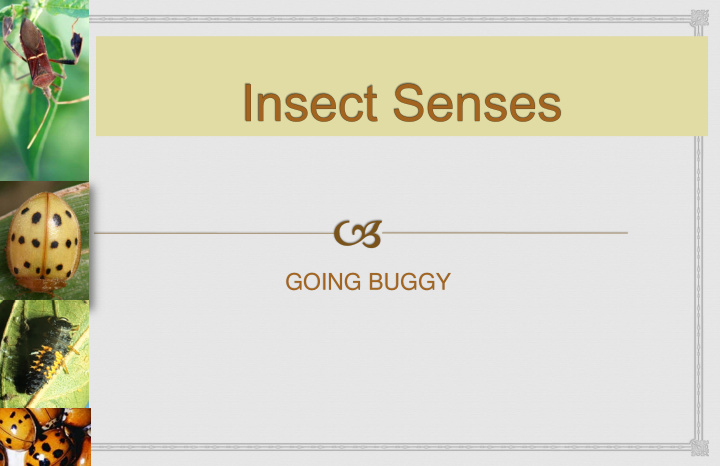



GOING BUGGY
Insect Senses - Eyesight Some insect eyes see light we can’t. It’s called ultraviolet light. Bees, for example, don’t go to flowers because of the color, but because of the ultraviolet light they see.
Insect Senses - Eyesight
Insect Senses - Eyesight In this picture, what about the flower the bee sees is more obvious? ANSWER: The area around the food source is highlighted! So flowers emit a form of UV light to get pollinators to them, how smart!
Insect Senses - Eyesight Insects do not see all the colors we see. Bees see blue-green, blue, violet and ultraviolet light. Some insects do not see red. ACTIVITY 1: Have the students look through the cellophane. Tell them to describe what the insects’ world looks like through it.
Insect Senses - Eyesight
Insect Senses - Eyesight The shape of the insects’ eyes affects how they see it. Insects have 2 compound eyes with 2 simple lenses. ( ACTIVITY 2: give each student a roll with straws to look into, they must hold it away from their eye about 6”).
Insect Senses - Eyesight
Insect Senses - Smells Insects use smell to detect many different things. What do you think these things might be? Food Nest Partners Very little smell is needed for an insect to find it. Activity 3: Have the students search the location and find the red ball on a wire. OPTIONAL ACTIVITY: A small box containing film canisters are filled with various scents, a number is on the bottom of each canister. Mix up the containers then hand out one canister to each student. Have them find the other canister with their same scent. A canister decoding chart is in the guide book
Insect Senses - Sounds Many animals make and use sounds for specific purposes To "talk" to others of their own kind To call to each other to find mates To warn of approaching danger To keep in touch when they cannot see each other Some use sound to find prey. (Ask for an example: ie., spider using sounds of beating wings on web) Cicadas make sound with tymbals that are ribbed membranes, each having strong muscles attached to it. Contracting and relaxing these internal tymbal muscles causes the tymbals to rapidly vibrate and produce pulses of sound. ACTIVITY 4: Make a sound like a cricket. Use the toy in the Ziploc bag to give the students a cricket sound. The toy is a Ziploc bag in the guidebook.
Insect Senses - Sounds
Insect Senses - Sounds Ask students to describe the kinds of sounds they have heard insects making. You might have them imitate a bee and a cricket. Ask students how they made their “insect sounds.” Point out that although students were able to imitate insect sounds by using their mouths or throats, insects do not make sounds with either of those body parts. Review with students what they know about insects. How do they make sounds? Make sounds in two ways— by moving their wings very quickly, as a bee or housefly does by rubbing their legs together (called stridulation), as a cricket or cicada does. Ask students if they can think of any examples of insects using sound for communication. One important example is bees guiding other bees to the hive, or nest.
Insect Senses
Recommend
More recommend